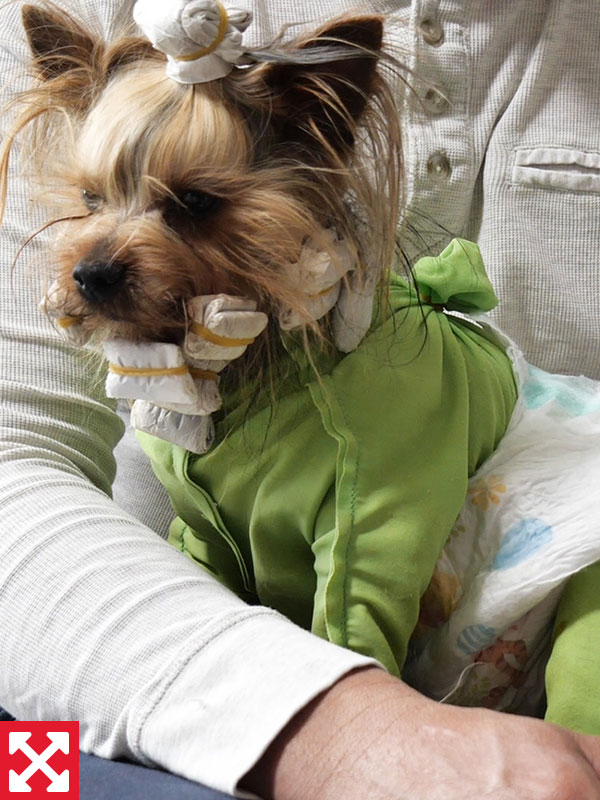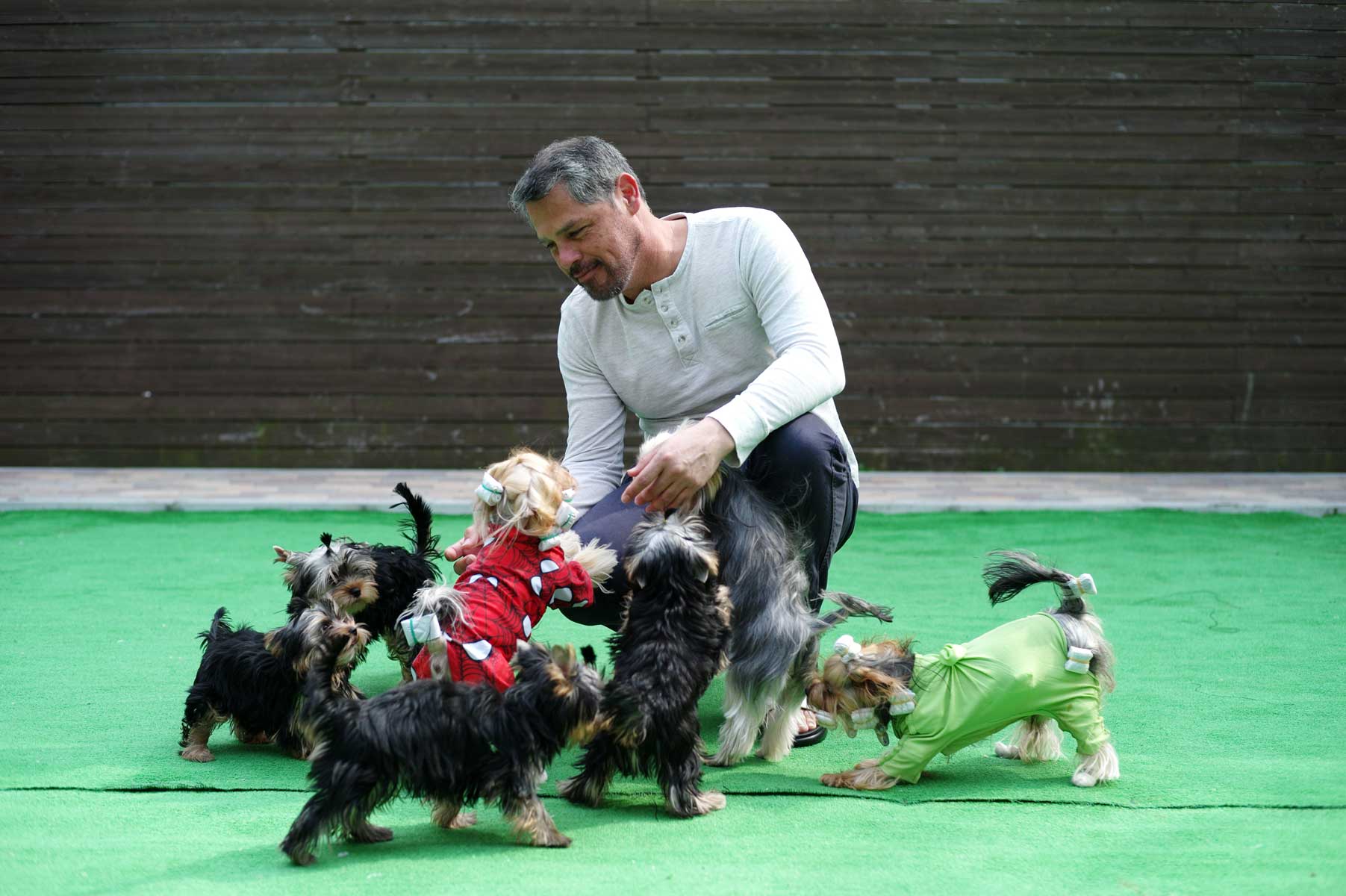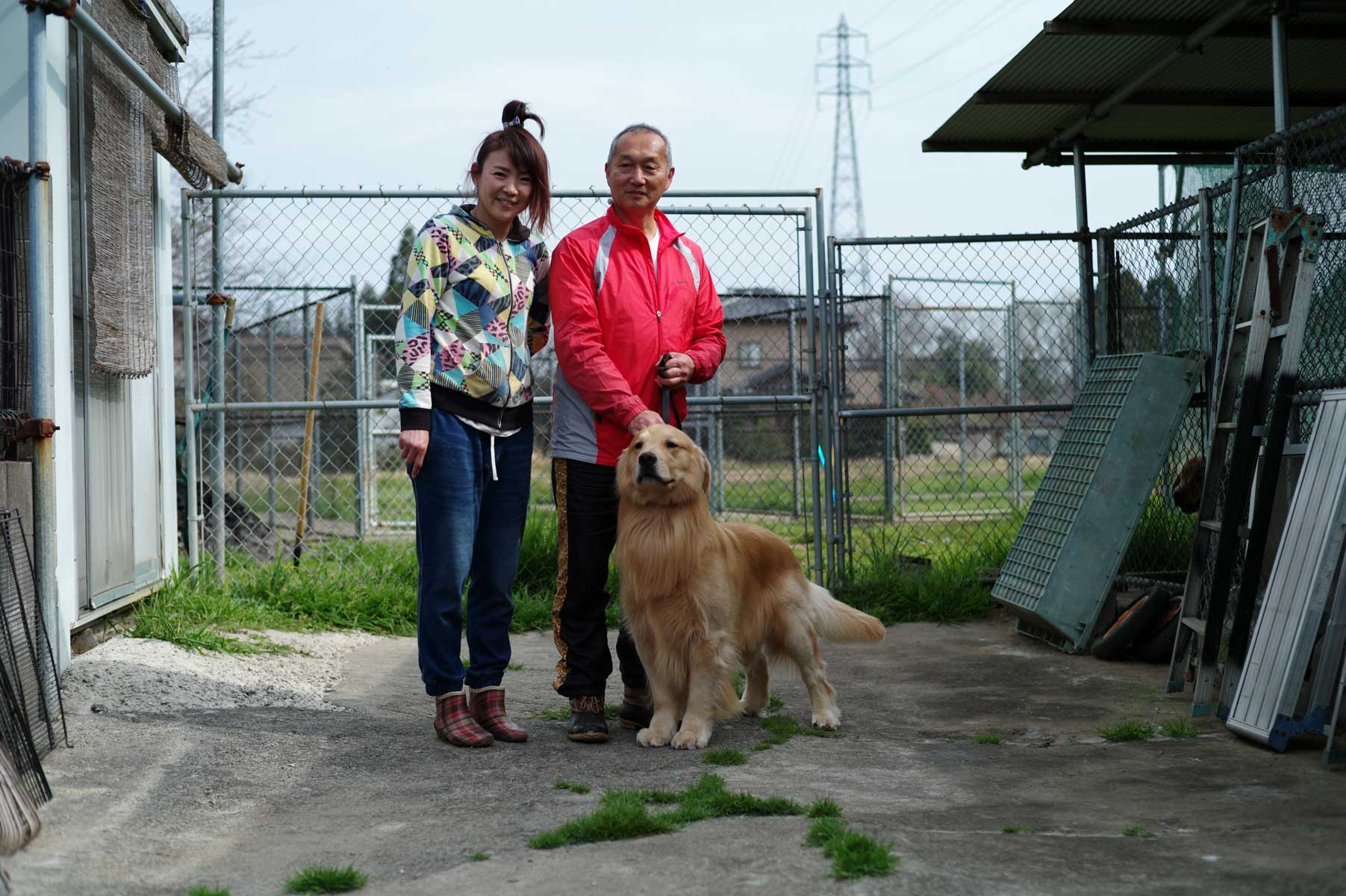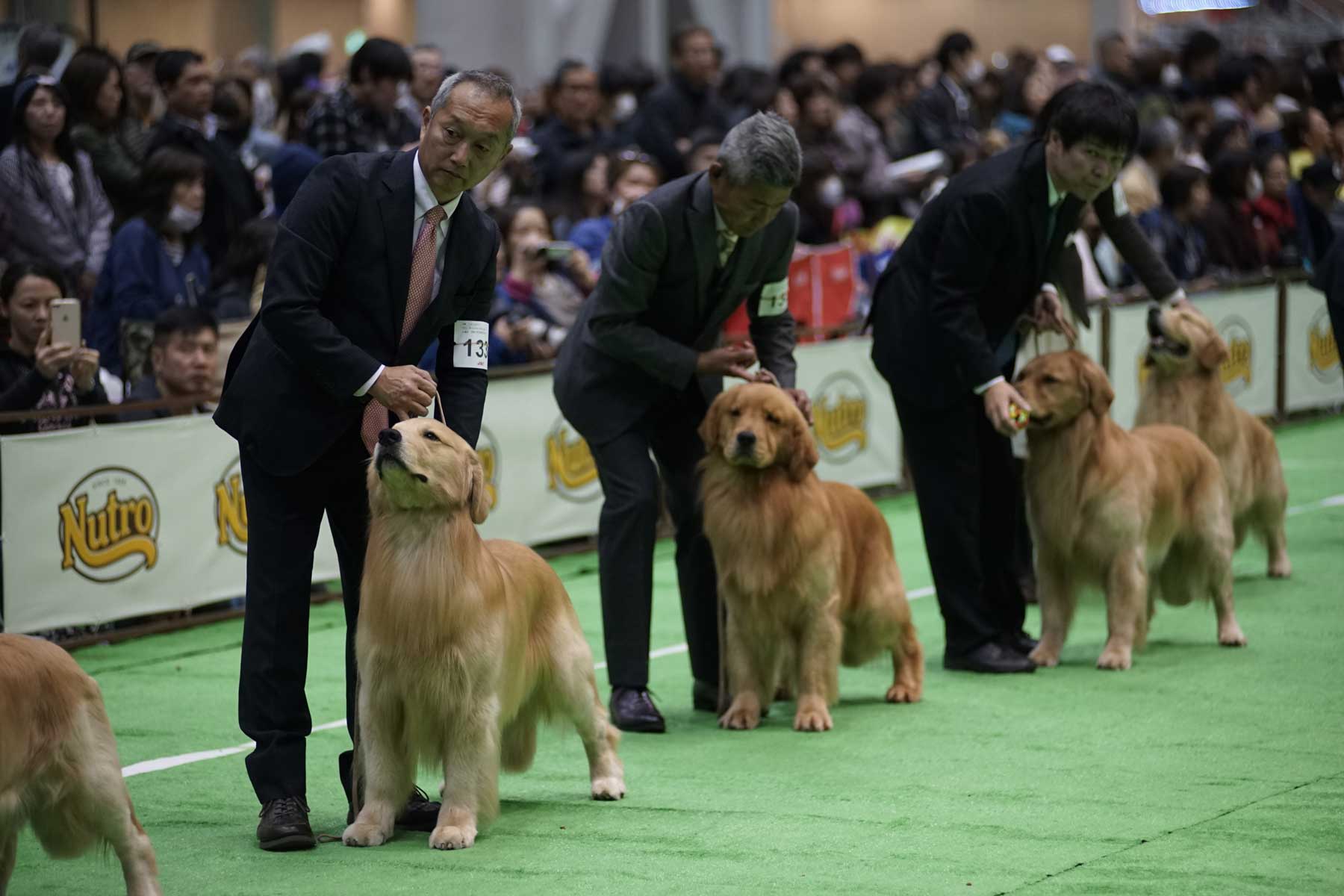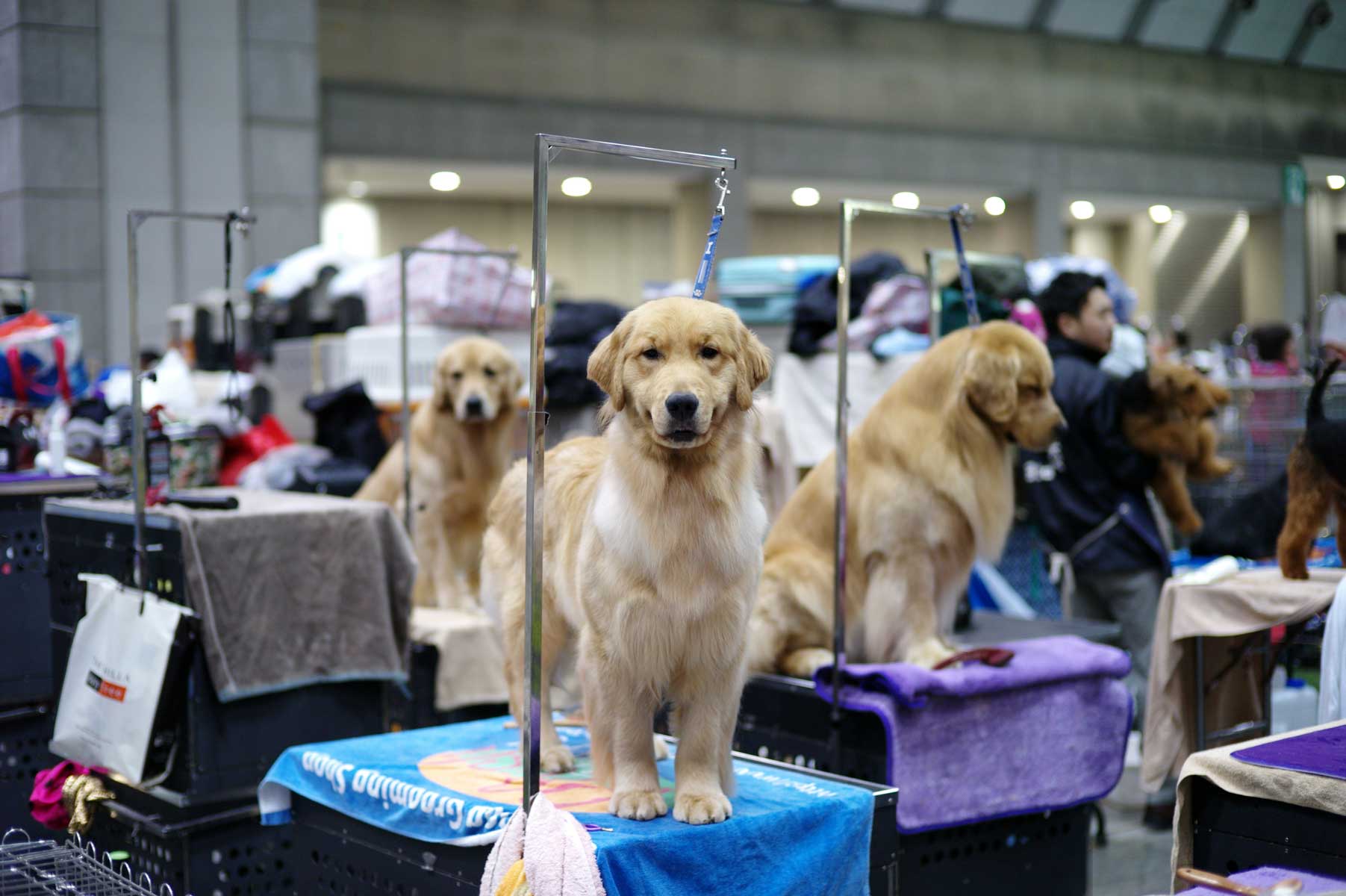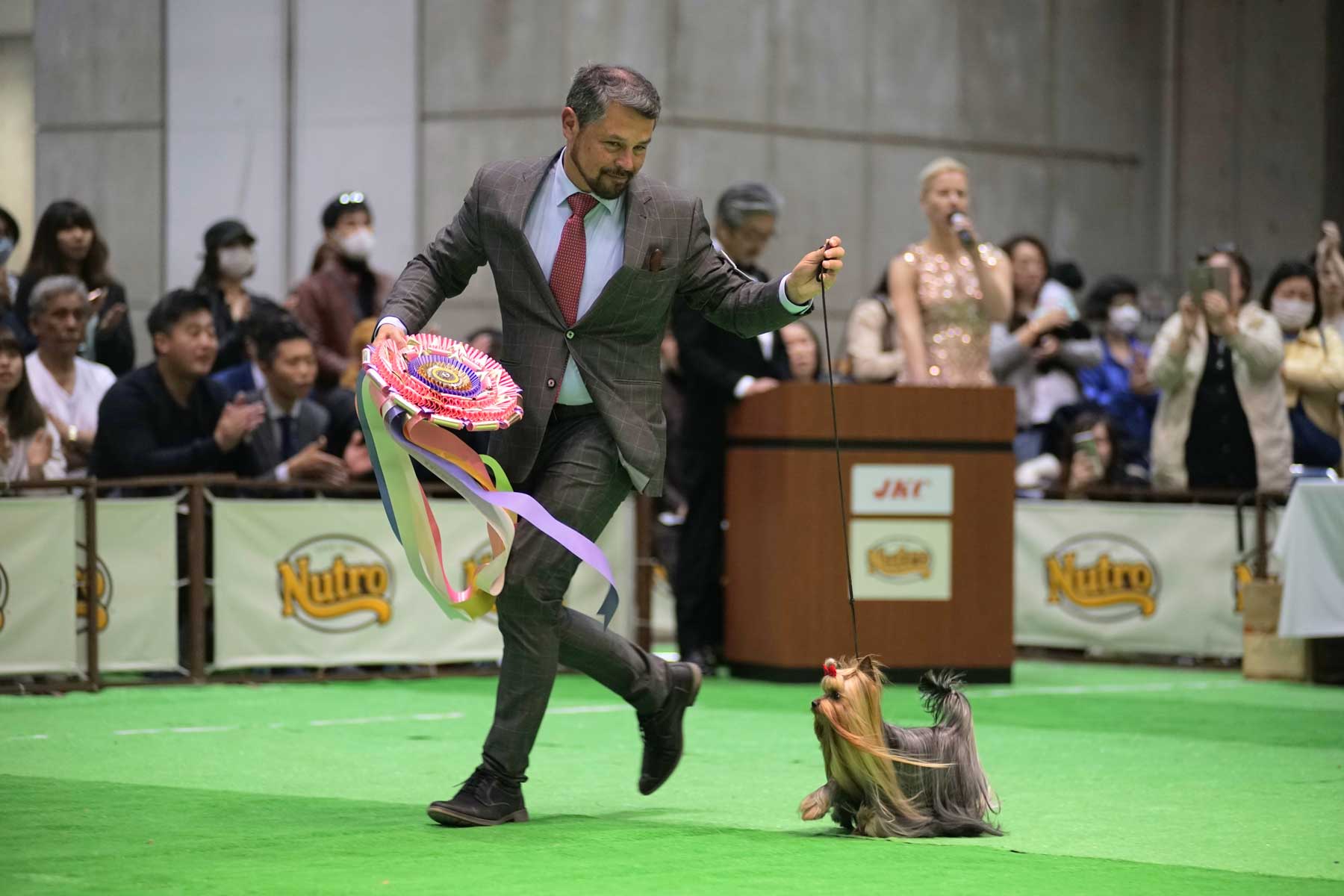LIFE
Best in show
Japan’s pooches puttheir best paw forward
Handler Sergio Amien parades with Yorkshire Terrier Royal Precious JP’s F4 Conan at the Japan International Dog Show on March 31 at Tokyo Big Sight. RYUSEI TAKAHASHI
Triumph goes hand in hand with heartbreak at prestigious event
ANDREW McKIRDY
Staff writer
Royal Precious JP’s F4 Conan — to give him his pedigree name — does not look like a champion as he lounges on his owner’s sofa wearing a pea-green bodysuit.
The long hair on his face is wrapped up in paper bundles fastened with rubber bands, and he has a baby’s diaper wedged over his rear end.
Just three weeks earlier, Conan, as he is known for short, won the best of breed prize for Yorkshire terriers at Britain’s Crufts, one of the biggest and most prestigious dog shows in the world. He narrowly missed out on a place in the best in show competition, finishing second in the toy dog category behind a papillon that went on to win the overall title.
Today, however, Conan is more interested in sniffing inquisitively at the visitors to his owner’s house in Nerima Ward, Tokyo.
“They must have a normal life,” says his handler and trainer, Sergio Amien, who was born in Costa Rica but lives with Conan and several other dogs in Segovia, Spain.
“They have to be able to go outside and run around,” he says. “That’s very important. Many people think that dog shows give dogs a hard life, but his life is easy.”
Amien and Conan are here for the annual FCI Japan International Dog Show being held at Tokyo Big Sight from March 30 to 31. The event is the biggest dog show in Japan, with 2,201 canines representing 134 different breeds at this year’s edition, which marks the 70th anniversary of the foundation of the Japan Kennel Club.
Amien and Conan are staying with Yoshiko Obana, Conan’s owner and a Yorkshire terrier breeder of worldwide repute. Obana started breeding in 2003 and became the first Japanese ever to claim a prize at Crufts with a domestically bred dog when she won best of breed in 2013 with Juliana, her brilliant protege who went on to become a champion in 18 different countries under Amien’s guidance.
Obana sent Conan to live with Amien in Spain two years ago in the hope that he could follow in Juliana’s footsteps. He has lived up to expectations so far, going into the Japan International Dog Show with five career best-in-show awards to his name.
Amien is confident that Conan can enjoy more success at Tokyo Big Sight, but the handler is taking nothing for granted as he relaxes in Obana’s living room two days before the event gets underway.
“He has a chance but, of course, nothing is 100 percent secure,” says the 50-year-old Amien. “If he behaves properly, he may have a chance to win best in show this year. But there are so many good dogs around also, so you never know. That’s why every weekend is different. Even with the same dog and the same judges, you don’t necessarily have the same result.”
Amien is one of the world’s top handlers and has won seven prizes at Crufts in the last nine years. He first started handling dogs 34 years ago and now travels all over Europe and beyond, showing dogs that either he has bred or that belong to clients keen to tap into his special brand of alchemy.
Amien says handling a dog is “like an artist doing a painting or a sculpture.” The key is “to adapt yourself to the dog and don’t try to make the dog do what you want.”
Obana admits that she feels jealous of the bond that Conan has established with his handler, but she is willing to make that sacrifice in the pursuit of excellence.
“I trust him,” Obana says of Amien, whom she has been working with for the past eight years. “It’s not just down to the dog. If you don’t have a good handler who can communicate well with the dog, it’s impossible to win.”
Obana and Amien are not the only people eyeing success at this year’s Japan International Dog Show.
Masahiro Otsuka is a professional handler, breeder and handler instructor who lives in Inashiki, Ibaraki Prefecture, with his wife, Sachiko, and more than 10 dogs, some they have bred themselves and some they look after for clients.
Otsuka will be entering nine dogs into the competition — five golden retrievers, three Bernese mountain dogs and one corgi. Most of these breeds are big in size, and Otsuka’s house, as he and Sachiko groom and exercise the dogs four days before the event, is a riot of noise and activity.
“The period when they are growing is very important,” says Otsuka, struggling to make himself heard above the cacophony of barks.
“The amount of nutrition they get during that time is a big factor. If you give them lots of nutritious food when they become adults, they just get fat,” he says.
“You have to give them lots of supplements when they’re growing, and food that’s high in nutrition like raw meat. I give them beef and horse meat. Horse is comparatively cheap. Dogs don’t really care about food that humans enjoy. If you ask a dog which they prefer, normal beef or Kobe beef, it’s all the same to them.”
Otsuka starts his day by getting up and taking the dogs out to the toilet, before exercising them in turns in a nearby field until noon. After lunch, the dogs sleep until 3, wake to relieve themselves, sleep again until 6, eat and exercise again, then go back to sleep until morning.
Grooming, when it needs to be done ahead of a show, takes around four to five hours for each dog. Show judges have in mind a particular ideal of what each breed should look like, and skillful grooming can accentuate the animal’s lines and contours.
Otsuka and Sachiko work together to shampoo and blow dry their dogs before trimming their nails and cutting their hair with scissors. The dogs must stand patiently on a raised table throughout the entire process.
“They’re used to it,” says Sachiko, as she blasts a golden retriever with a hair dryer, standing near an extractor fan crusted with a thick layer of dog hair. “They’ve all been groomed like this since they were puppies, so they can stand for a long time without getting sick of it.”
Otsuka says the cost of keeping show dogs depends on the level of success the owner is aiming for and he concedes that “it is possible to spend large amounts of money,” without putting an exact figure on it.
He himself is aiming for glory at the Japan International Dog Show, and his hopes are highest for his 3-year-old golden retriever, Zeus.
“He was entered into a big show last week and, sadly, he only finished second,” Otsuka says. “I hope to win this time.”
Three Yorkshire terriers wait to be groomed at the Japan International Dog Show at Tokyo Big Sight on March 31. RYUSEI TAKAHASHI
When the main event rolls around at Tokyo Big Sight, the best of breed competitions take place in nine rings set up around the venue. On the periphery are a series of paddocks for owners and handlers to get their dogs ready, and stalls selling everything from dog food to pet portraits.
Entrants are divided by breed and split into groups of four or five to parade in front of a single judge. The judge, at various points, instructs the handlers to run or walk the dogs round in a circle, kneel down and hold them steady, and lift them onto a table for individual inspection.
The judge is looking for the dog that best fits the ideal standard of that particular breed, and is considering several elements, including size, coat texture, color, physical health, mental alertness and movement.
With such fine margins separating the contenders, however, personal preference is often the deciding factor.
“I think that’s the problem of beauty,” says Laurent Pichard, a Swiss judge with over 30 years of experience who is officiating this year’s Yorkshire terrier competition. “It’s a little like working in fashion. You have to have a dog that is the closest to the standard, and then for sure you have to let your preference speak to you.”
The handler’s aim is to show off the dog in the best possible light, and most will keep a favorite toy or a chunk of dried sausage in their pocket to attract the animal’s attention at critical moments. Amien is not above using such tricks of the trade, but he insists the real groundwork is laid far in advance.
“When you bring a dog to a show, you are supposed to have done your work at home,” he says. “That means taking care of their temperament and training them. It’s difficult to come here with a dog that isn’t already prepared. Some people do, and that’s why they have problems.”
The Japan International Dog Show is preceded one day by the smaller Japan Kennel Club Multi Specialty Show, which is open only to certain breeds, including Yorkshire terriers. Conan gets the weekend off to a perfect start by carrying off the best in show prize.
To do the same at the main event on March 31, he needs to win four rounds of the competition. Unlike dog shows in Europe and the United States, the Japanese show divides males and females into two separate events, with a best male and best female being chosen and then going head to head to crown the overall best in show.
Conan takes care of the first piece of business, claiming the best male Yorkshire terrier prize and advancing to the next phase, which brings together the winner of each of the male terrier breeds.
“I think he’s very stylish, the proportions are very good, he had a very typical expression for a Yorkshire terrier, well-set ears, and he has a lot of showmanship,” says judge Pichard. “He has everything. He is a beautiful Yorkshire terrier.”
Otsuka, on the other hand, is not faring so well. None of his eight dogs — including Zeus — has made it through the best of breed stage. With the show not being held next year because of Tokyo Big Sight’s unavailability due to the Olympics, he is left to reflect on what could have been.
“The results for all the dogs today were disappointing,” he says. “I don’t think the type of dogs I put into the show met the judge’s particular preference. The show isn’t being held next year so I really wanted to get a good result this time. If Zeus can stay in good condition, I’d like to enter him again.”
Conan continues to impress the judges, duly winning the terrier category to book his place in the male best in show event. This brings together the winner of each of the 10 categories, pitting a tiny bichon frise against a horse-like Afghan hound and all sizes in between.
By this point, the rings have been reconfigured so that only one remains, and a large crowd assembles around it to watch the main event. In a serious boost to Conan’s chances, Pichard — a proven fan — has been chosen to judge. Amien leads Conan out and begins to weave his magic, coaxing and encouraging him around the ring with judicious use of the sausage.
It pays off. Conan is named best male in show, and the crowd waits to see which female will join him in the final. His opponent will be Kang Yi Shi Shang Rebecca, a medium poodle from China with an enormous, gravity-defying pompadour.
The two dogs and handlers are called out to the ring and ushered into the spotlight. The emcee prolongs the tension by bringing out a singer in a floor-length evening dress to perform while Pichard reaches his judgement.
Finally, the winner is announced. Out of all 2,201 starting entrants, Conan is named best in show.
“I’m very excited, happy, tired, relaxed — everything at the same time,” says a beaming Amien. “I always had hope, but you can never be sure.
“This could be his last show, maybe. After winning this, there’s not much you can win in Japan.”
As the person who pays for his training, his food, his travel and all the other myriad expenses that come with keeping show dogs, however, it is Obana who will decide Conan’s future. Shortly after lifting the trophy, she is already targeting success at shows in the United States.
She is also happy to savor the moment, though, and as the crowd begins to filter out of the arena, she reflects on the sacrifices that brought her here.
“It’s really difficult to look after long-haired dogs like Yorkshire terriers,” she says. “Every day is a lot of hard work. You’ve got to wrap their hair up every day. Now it feels like it’s all been worth it.”

